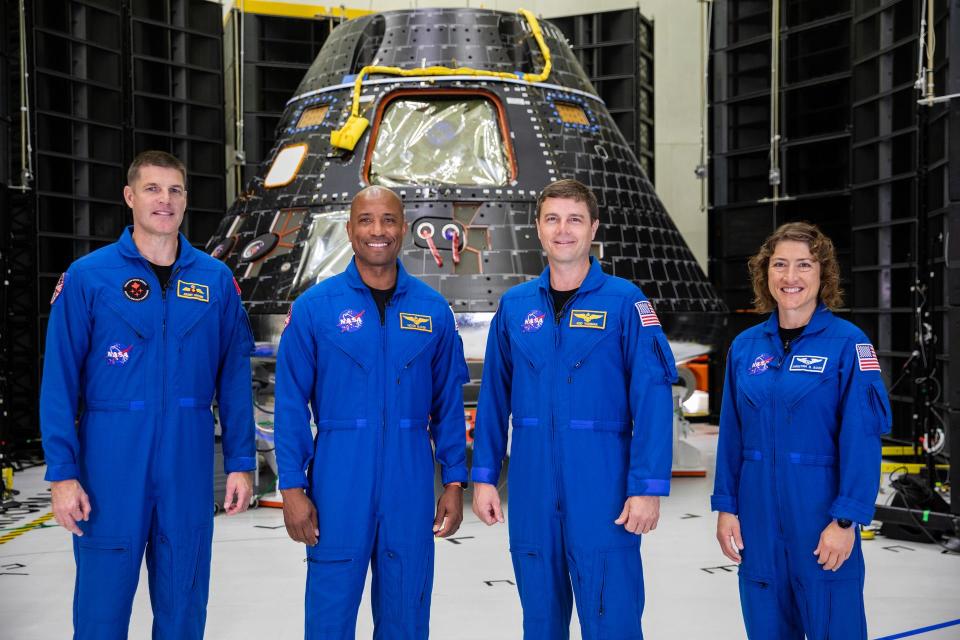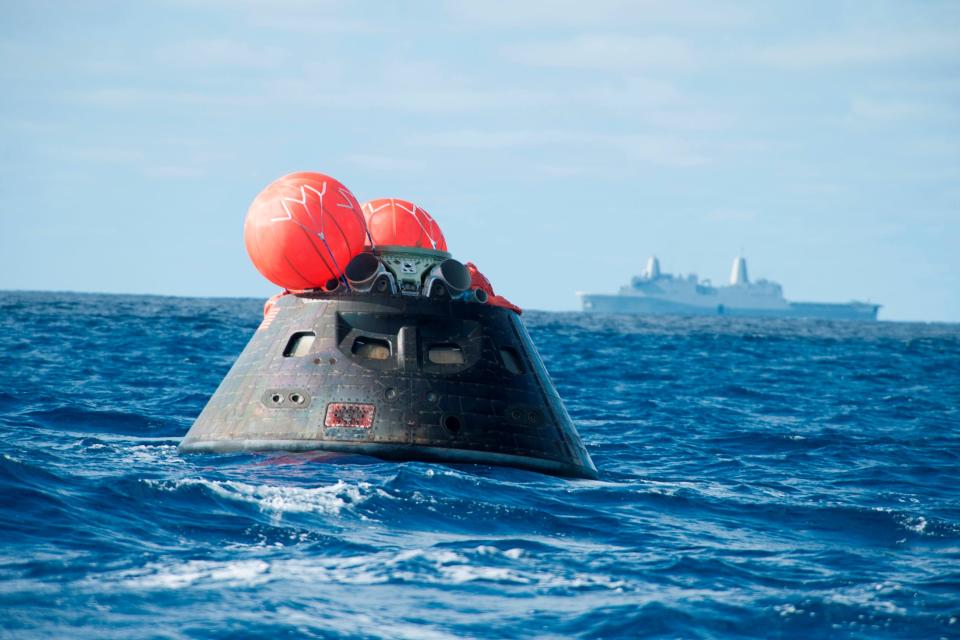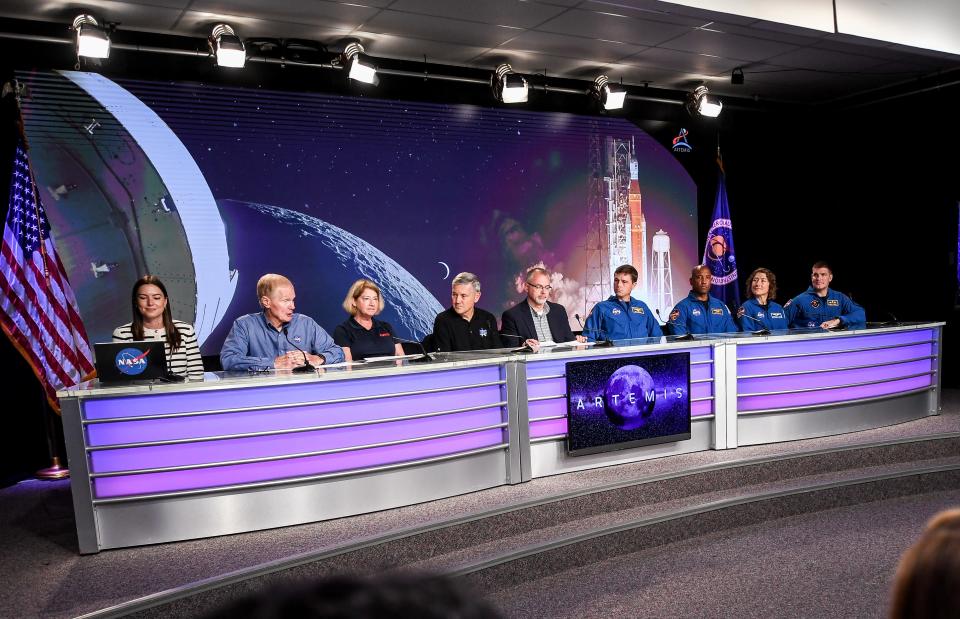NASA moving toward Artemis II liftoff, but program's future remains uncertain
- Oops!Something went wrong.Please try again later.
This past week, the four-person crew of NASA’s Artemis II mission got their first chance to visit Kennedy Space Center where, as early as next year, the Orion spacecraft that will be their home for a 10-day test flight to the moon and back is being prepared.
"We made it to Kennedy. This is awesome," NASA astronaut and Artemis II mission Commander Reid Wiseman told journalists during a news conference. "We're fired up. It's a great day when you walk around the corner at the Neil Armstrong Operations Checkout Facility, and there's a spacecraft that you're going to ride in."

Agency officials also provided updates on everything Artemis, from the crew's training, work being done at KSC, and the build status of flight hardware for NASA's massive 320-foot Space Launch System rocket. And while officials were optimistic about the timeline for Artemis II, thrown into question was the future of the lunar-focused program, particularly Artemis III, and the key goal of returning American astronauts to the surface of the moon in 2025.
NASA's plans for the Artemis III mission depend on SpaceX's Starship human landing system. SpaceX's first, and only, launch of Starship in April resulted in a catastrophic loss of the rocket and its Super Heavy booster.
Jim Free, NASA associate administrator of Exploration Systems Development, said the agency is working with SpaceX and "trying to understand their schedule some more."
While the company said it is working toward another Starship flight test sometime before the end of this year, whether or not that is feasible will ultimately be determined by the Federal Aviation Administration. FAA sign-off is needed due to the ongoing investigation after the first test flight exploded.
If SpaceX isn't ready for the Artemis III launch date set for the end of 2025, "(NASA) may end up flying a different mission, if that's the case," Free said, stirring in some uncertainty about what's in store for Artemis beyond next year.
Artemis II: Crew mission and recovery training
Since the crew of Artemis II was announced in April, NASA astronauts Reid Wiseman, Victor Glover, Christina Koch, and the Canadian Space Agency's Jeremy Hansen have traveled across the country to witness the progress being made with their mission which is slated to launch toward the end of next year.
"It kind of started with a bit of a media blitz, but then we got down to work," said Wiseman. "We've been studying spacecraft systems at the Johnson Space Center."
After hitting the books and the classroom last month to begin training in simulators to familiarize themselves with the flight profile and different phases and milestones of their mission, the crew headed out to California to visit Naval Base San Diego and meet the Orion recovery team.
"We were out in San Diego working with our beloved United States Navy, and the rescue and recovery forces working alongside NASA," Wiseman said.

Once Orion brings the Artemis II crew home for a splashdown landing in the Pacific Ocean, joint NASA and Department of Defense teams will help the astronauts out of the capsule and then load it into the hull of an awaiting recovery vessel.
While the crew didn't participate in the first full-scale recovery test, they are expected to head back early next year to participate in a practice run.
"Throughout their training flow, the crew also will refine their understanding of water survival and emergency exit operations, practice medical and exercise device use, and learn how to use Orion’s other day-to-day life support systems, including for food preparation," the agency said in a release.
Upgrades at Kennedy Space Center for crewed missions
Back at KSC, teams are upgrading ground systems that are crucial to successfully launching the first crewed mission beyond low Earth orbit since the Apollo 17 mission in 1972. All NASA Artemis missions liftoff from Launch Pad 39B.
The elevators on the 380-foot Mobile Launcher were replaced after sustaining damage during last year's uncrewed Artemis I launch. An emergency egress life safety system was also added to the launcher — a requirement for crewed launches that wasn't necessary for last year's Artemis I mission. It will enable the astronauts and close-out crew personnel to evacuate away from the Orion capsule and the SLS rocket during the countdown in the event of an emergency.

At pad 39B, crews have completed the construction of an additional hydrogen sphere that will hold 1.4 million gallons of liquid hydrogen which will be used for loading propellant into the SLS's core stage.
When the SLS's 212-foot-tall core stage ships to KSC from NASA's Michoud Assembly Facility in Louisiana, teams will begin stacking operations atop the launcher inside KSC's massive Vehicle Assembly Building.
That process is expected to begin sometime this November.
For subscribers: Mars helicopter 'Ingenuity' piloted by NASA smashes flight expectations
What's ahead for the Artemis program?
If the Artemis II mission goes off without a hitch, NASA's plan to launch Artemis III about a year later, in December 2025, could still be in jeopardy.
For that mission, up to four astronauts will travel to lunar orbit in an Orion capsule. The rest hinges on SpaceX's success with its Starship program. NASA intends to transfer the Artemis III crew from Orion to a SpaceX Starship, which will then be used as a sort of moon elevator to deliver them to the lunar surface.
The astronauts for that mission haven't yet been chosen, but NASA has said it will include the first woman and the first person of color to land on the lunar surface. But it's not clear how the selection might change if the agency chooses a different Artemis III mission objective that doesn't involve a moon landing.
Pressure is on SpaceX.
"They need to launch multiple times, not just for us, but for them," said Free. "We really want to see them find the success in their launches."
For subscribers: 60 years ago, women broke the ceiling to space. More are flying with every mission
Getting Starship ready isn't the only step toward a lunar landing, NASA also needs the lunar exploration spacesuits to be ready on time. Those suits are being developed by another Artemis program commercial partner, Houston-based Axiom Space, which was announced in March.
"We really are trying to get in the details of that schedule because when we come up with a date, December of 2025, or whatever that date might be, we want to have confidence for our teams, that we all have a realistic path to get there," Free said.
Contact Jamie Groh at JGroh@floridatoday.com and follow her on Twitter at @AlteredJamie.
This article originally appeared on Florida Today: NASA's Artemis II on track; questions over moon landing mission remain

